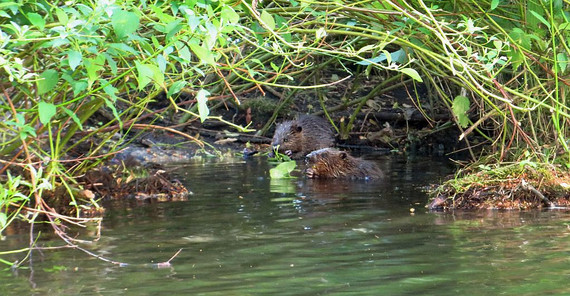It is droll but not always welcome. The beaver’s way of life alters entire landscapes like hardly any other animal and has thus often been targeted by farmers and flood control officers. The fact, though, that Europe's largest rodent is beginning to feel at home again in Brandenburg is good news for environmentalists. These animals restore watercourses and create new habitats for amphibians, insects, and plants. They even feel comfortable in urban areas. In her master’s thesis, ecology student Janine Treue is examining where in the city these cute mammals reside, what vegetation is available, and how tree damage can be minimized.
They are at home on the pond Maschinenteich in Sanssouci Park, the Nuthe River in the Schlaatz district and, of course, the Havel River – Treue estimates that about 100 beavers are living in Potsdam,. “They are used to the city noise.” She knows when and where the rodents are visible, regularly setting off at dusk to observe “her” beavers. “It has become difficult to find a place where they are not,” the life scientist explains. “The river areas in the city of Potsdam are all inhabited; only a few lakes are still beaver-free.
Only upon a second glance does she spot their traces along the Havel, next to the Babelsberg public swimming area. A young willow bush on the banks gives away the beaver territory: Two arm-thick branches have been completely gnawed off. The big, old linden tree only 10 meters from the banks seems not to have interested the beavers. Its bark has not a single bite mark. “Beavers rarely use older trees, and if they do, it is only when they cannot find any other nourishment,” Treue explains.
She pulls out a pen and a clipboard. “Eupatorium, water horehound, and burr marigold,” she notes. The beavers’ menu comprises about 150 plant species. Tree bark – mainly from young willows and poplars – is their winter diet. Treue is studying 9 sites in her thesis, documenting the riverside vegetation as well as disruptive factors like streets and large houses. Five of these sites have already been populated by beavers, and four are potential habitats that do not yet belong to their own territories. Treue statistically analyzes if the diversity of forage plants and the presence of disruptive factors influence urban beaver population.
Ecologists consider it a success story that this animal feels at home again in Potsdam. After World War II, the beaver was critically endangered in Germany. A residual population of only 200 survived in the Elbe region. In the 1950s and 1960s, the beavers, also aided by targeted stocking began repopulating their original habitats from there. “The first beaver was spotted in the Havelland region in 1955,” says Ralf-Udo Mühle, who is supervising Treue’s master’s thesis. Mühle, head of the Ecological Center Gülpe, stresses, “The beaver enriches the landscape even though agriculture has come to see it as a pest.”
Potsdam’s main concern is likely the damage to the vegetation in old parks and gardens. Biologists doubt, however, that beavers will overpopulate and rampage through the palace park, felling large quantities of old trees. “The more beavers there are living in an area, the smaller the territory and the fewer the offspring,” says Treue. “The population will regulate itself within a few years.” Not everybody is as easygoing as the researchers. For some years now, special managers have been in the field to prevent conflict between humans and beavers. Treue will also be developing possible approaches for urban beaver management. She already has a few suggestions. “Wire netting can prevent damage to old trees. Put up fences around properties to keep beavers out, and leave out wood from willow trees at the riverside as a source of food.” She also calls for a relaxed approach because beavers are active only near banks. “They venture no more than 20 meters from the water.”
Text: Heike Kampe, Translation: Susanne Voigt
Online-Editing: Agnes Bressa
Contact Us: onlineredaktionuuni-potsdampde

